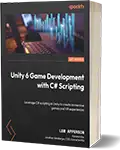Unity 6 Game Development with C# Scripting
Programming
Book Details
Book Title
Unity 6 Game Development with C# Scripting
Author
Lem Apperson
Publisher
Packt Publishing
Publication Date
2025
ISBN
9781835880401
Number of Pages
488
Language
English
Format
File Size
10.5MB
Subject
game-development
Table of Contents
- Cover
- Title Page
- Copyright and credits
- Foreword
- Contributors
- Table of Contents
- Preface
- Part 1: Foundational Concepts
- Chapter 1: Getting Started with Unity and C# – Game Objects and Components
- Technical requirements
- Unity interface overview
- Exploring the Unity Editor
- Creating a C# script
- Basic concepts of C#
- Summary
- Chapter 2: Creating Your First Unity Project – Mastering Scenes and Assets
- Creating a new project in Unity
- Navigating the Unity Editor interface
- Importing and managing assets
- Basic GameObject manipulation
- Preparing your first scene
- Summary
- Chapter 3: C# Fundamentals in Unity – Variables, Loops, and Troubleshooting Techniques
- Technical requirements
- An introduction to C# syntax
- Variables and data types
- Control structures in C#
- Writing basic functions
- Exploring Unity-specific functions
- Debugging C# scripts
- Summary
- Chapter 4: Exploring Unity’s Scripting Anatomy
- Technical requirements
- Understanding MonoBehaviour
- Exploring Unity’s script life cycle and event order
- Responding to player input
- Script communication
- Summary
- Part 2: Intermediate Concepts
- Chapter 5: Mastering Unity’s API – Physics, Collisions, and Environment Interaction Techniques
- Technical requirements
- Accessing game components
- Utilizing physics and collisions
- Managing game scenes and environments
- Advanced API features
- Summary
- Chapter 6: Data Structures in Unity – Arrays, Lists, Dictionaries, HashSets, and Game Logic
- Technical requirements
- Understanding arrays and Lists
- Exploring Dictionaries and HashSets
- Custom data structures in Unity
- Data structures for game logic
- Summary
- Chapter 7: Designing Interactive UI Elements – Menus and Player Interactions in Unity
- Technical requirements
- Designing UI elements in Unity
- Scripting player inputs
- Building dynamic menus
- Custom interactions with GameObjects
- Summary
- Chapter 8: Mastering Physics and Animation in Unity Game Development
- Technical requirements
- The core concepts of Unity physics
- Animating game characters
- Environmental interactions
- Advanced animation techniques
- Summary
- Part 3: Advanced Game Development
- Chapter 9: Advanced Scripting Techniques in Unity – Async, Cloud Integration, Events, and Optimizing
- Technical requirements
- Asynchronous programming and coroutines
- Understanding coroutines in Unity
- Advanced data management
- Creating custom event systems
- Script optimization techniques
- Summary
- Chapter 10: Implementing Artificial Intelligence in Unity
- Technical requirements
- An overview of the role of AI in gaming
- An introduction to Unity’s AI support
- Implementing pathfinding
- AI decision making
- Behavioral AI for NPCs
- Summary
- Chapter 11: Multiplayer and Networking – Matchmaking, Security, and Interactive Gameplay
- Technical requirements
- The basics of networking in Unity
- Building a multiplayer lobby
- Synchronizing game states
- Handling network latency and security
- Summary
- Chapter 12: Optimizing Game Performance in Unity – Profiling and Analysis Techniques
- Technical requirements
- Profiling and identifying bottlenecks
- Memory management in Unity
- Optimizing graphics and rendering
- Efficient scripting and code optimization
- Summary
- Part 4: Real World Applications and Case Studies
- Chapter 13: Building a Complete Game in Unity – Core Mechanics, Testing, and Enhancing the Player Experience
- Technical requirements
- Game concept and planning
- Designing game mechanics
- Integrating assets and levels
- Incorporating animations and audio
- Polishing and testing
- Summary
- Further reading
- Chapter 14: Exploring XR in Unity – Developing Virtual and Augmented Reality Experiences
- Technical requirements
- Fundamentals of VR in Unity
- Building AR experiences
- User interaction in VR/AR
- Performance optimization for immersive technologies
- Summary
- Chapter 15: Cross-Platform Game Development in Unity – Mobile, Desktop, and Console
- Technical requirements
- Understanding platform-specific challenges
- Adapting games for MOBIle devices
- Responsive UI design
- Testing and debugging on multiple platforms
- Summary
- Chapter 16: Publishing, Monetizing, and Marketing Your Game in Unity – Strategies for Advertising and Community Building
- Game publishing platforms
- Marketing and promoting your game
- Effective game monetization strategies
- Community engagement and support
- Summary
- Addendum: Unlocking Unity 6: Advanced Features and Performance Boosts
- Index
- Other Books You May Enjoy
